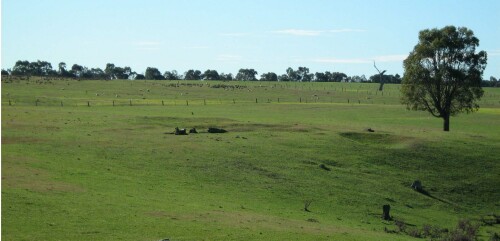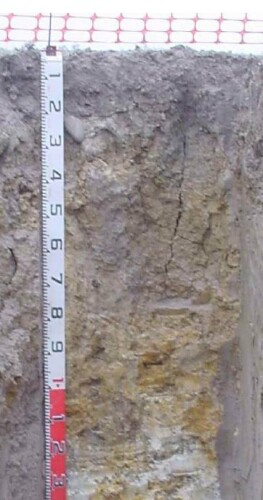EGS253
Location: Nicholson
Australian Soil Classification: Magnesic (and Eutrophic), Subnatric, Brown SODOSOL
Map Unit: Briagolong
Previous Site Name: EG253
General Landscape Description: Undulating rises.
Site Description: Upper slope, south aspect, 5% slope.
Land Use: Grazing.
Native Vegetation: Grassy woodland.
Geology: Pleistocene alluvial sediments.
 EG253 Landscape. Photo looking north-east from near the soil pit |
Soil Profile Morphology:
Surface Soil
| A1 | 0 – 15 cm | Very dark greyish brown (10YR3/2); fine sandy clay loam; weak medium sub-angular blocky structure; firm consistence dry; abrupt change to: |  EG253 Profile |
Subsoil | |||
| B21 | 15 – 40 cm | Dark brown (10YR4/3); medium clay; strong very coarse columnar, parting to strong fine angular blocky structure; very strong consistence dry; few (<10 %) rounded cobbles (<200 mm); diffuse change to: | |
| B22 | 40 – 90 cm | Greyish brown (2.5Y5/3); light medium clay; strong coarse very prismatic to lenticular, parting to strong fine angular blocky structure; very strong consistence moderately moist; diffuse change to: | |
| B23 | 90 – 120 cm cm | Greyish brown (2.5Y5/3) with few (<10%) coarse dark yellowish brown (10YR4/8) mottles; light medium clay; strong medium prismatic structure; very firm consistence moderately moist; diffuse change to: | |
| C1 | 120 – 170 cm cm | Light grey (2.5Y7/3) with many (20-50%) very coarse (>30 mm) yellowish brown (10YR5/8) mottles; light clay; massive. |
Key Profile Features:
- Strong texture contrast between the surface (A) and subsoil (B) horizons
- Quartz cobbles present in the upper subsoil.
Soil Profile Characteristics:
| - | pH | Salinity | |
Surface (A1 horizon) | Strongly Acid | Non-Sodic | None1 |
Subsoil (B21 horizon) | Moderately Acid | Sodic | None2 |
Deeper Subsoil (at 1 metre) | Slightly Alkaline | Strongly Sodic | Slight2 |
Chemical and Physical Analysis:
Horizon | Horizon Depth (cm) | pH (water) | pH (CaCl2) | EC dS/m | Organic Carbon % | Total Nitrogen % | Exchangeable Cations | Coarse Sand (0.2-2.0 mm) % | Fine Sand (0.02-0.2 mm) % | Silt (0.002-0.02 mm) % | Clay (<0.002 mm) % | Field cap. % w/w | Wilt. point % w/w | |||
Ca | Mg | K | Na | |||||||||||||
meq/100g | ||||||||||||||||
A1 | 0-15 | 5.4 | 4.6 | 0.07 | 1.9 | 0.15 | 1.7 | 1.1 | 0.1 | <0.1 | 17 | 55 | 17 | 7 | 17.0 | 4.8 |
B21 | 15-40 | 5.9 | 4.8 | 0.13 | 1.7 | 7.7 | 0.3 | 1.2 | 9 | 31 | 12 | 46 | 28.1 | 16.7 | ||
B22 | 40-90 | 7.8 | 6.6 | 0.26 | 0.8 | 7.6 | 0.2 | 2.4 | 7 | 36 | 15 | 38 | 27.1 | 15.6 | ||
B23 | 90-120 | 7.9 | 7.3 | 0.96 | 0.7 | 8.4 | 0.2 | 4.3 | 2 | 27 | 25 | 41 | 35.3 | 13.3 | ||
B24 | 120-170 | 7.7 | 7.2 | 0.89 | 0.6 | 6.1 | 0.1 | 2.5 | 1 | 43 | 29 | 24 | 33.1 | 14.1 | ||
Management Considerations:
Whole Profile
- The plant available water capacity is considered to be low (estimated at 38 mm) based on an effective rooting depth of 30 cm. The dense upper subsoil is likely to restrict the effective rooting depth.
Surface (A) Horizons
- The surface soil is strongly acid but it is unlikely the pastures could show a response to lime.
- The low wilting point indicates plants will be able to use very light rains when the soil is dry. Due to the low water storage capacity, plants will soon suffer moisture stress if follow-up rains don’t occur.
- Potassium levels are very low and a response to added potassium would be expected.
- Both the water holding capacity and the nutrient holding capacity is low. This can be enhanced by increasing the organic matter content of the soil by improving grazing management.
Subsoil (B) Horizons
- The subsoil is dense, sodic and cracks when dry. This will significantly restrict root growth in the subsoil.
- Soluble salt levels increase with depth and are high in the deeper subsoil. This may restrict the growth of deeper rooted salt sensitive species.
Profile Described By: Ian Sargeant (2011).


